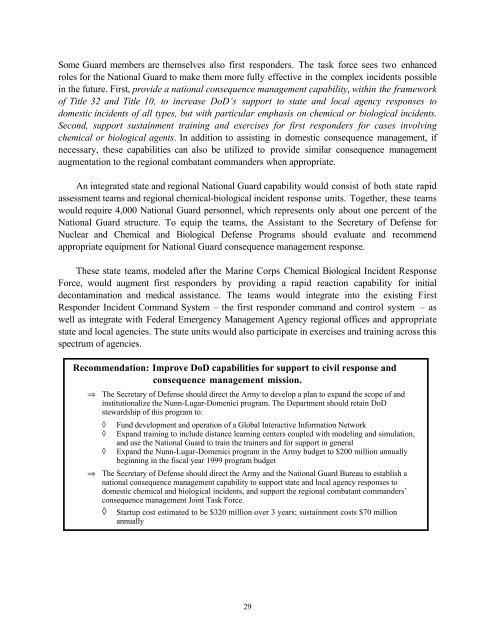DoD Responses to Transnational Threats - The Black Vault
DoD Responses to Transnational Threats - The Black Vault
DoD Responses to Transnational Threats - The Black Vault
You also want an ePaper? Increase the reach of your titles
YUMPU automatically turns print PDFs into web optimized ePapers that Google loves.
Some Guard members are themselves also first responders. <strong>The</strong> task force sees two enhanced<br />
roles for the National Guard <strong>to</strong> make them more fully effective in the complex incidents possible<br />
in the future. First, provide a national consequence management capability, within the framework<br />
of Title 32 and Title 10, <strong>to</strong> increase <strong>DoD</strong>’s support <strong>to</strong> state and local agency responses <strong>to</strong><br />
domestic incidents of all types, but with particular emphasis on chemical or biological incidents.<br />
Second, support sustainment training and exercises for first responders for cases involving<br />
chemical or biological agents. In addition <strong>to</strong> assisting in domestic consequence management, if<br />
necessary, these capabilities can also be utilized <strong>to</strong> provide similar consequence management<br />
augmentation <strong>to</strong> the regional combatant commanders when appropriate.<br />
An integrated state and regional National Guard capability would consist of both state rapid<br />
assessment teams and regional chemical-biological incident response units. Together, these teams<br />
would require 4,000 National Guard personnel, which represents only about one percent of the<br />
National Guard structure. To equip the teams, the Assistant <strong>to</strong> the Secretary of Defense for<br />
Nuclear and Chemical and Biological Defense Programs should evaluate and recommend<br />
appropriate equipment for National Guard consequence management response.<br />
<strong>The</strong>se state teams, modeled after the Marine Corps Chemical Biological Incident Response<br />
Force, would augment first responders by providing a rapid reaction capability for initial<br />
decontamination and medical assistance. <strong>The</strong> teams would integrate in<strong>to</strong> the existing First<br />
Responder Incident Command System – the first responder command and control system – as<br />
well as integrate with Federal Emergency Management Agency regional offices and appropriate<br />
state and local agencies. <strong>The</strong> state units would also participate in exercises and training across this<br />
spectrum of agencies.<br />
Recommendation: Improve <strong>DoD</strong> capabilities for support <strong>to</strong> civil response and<br />
consequence management mission.<br />
⇒ <strong>The</strong> Secretary of Defense should direct the Army <strong>to</strong> develop a plan <strong>to</strong> expand the scope of and<br />
institutionalize the Nunn-Lugar-Domenici program. <strong>The</strong> Department should retain <strong>DoD</strong><br />
stewardship of this program <strong>to</strong>:<br />
◊ Fund development and operation of a Global Interactive Information Network<br />
◊ Expand training <strong>to</strong> include distance learning centers coupled with modeling and simulation,<br />
and use the National Guard <strong>to</strong> train the trainers and for support in general<br />
◊ Expand the Nunn-Lugar-Domenici program in the Army budget <strong>to</strong> $200 million annually<br />
beginning in the fiscal year 1999 program budget<br />
⇒ <strong>The</strong> Secretary of Defense should direct the Army and the National Guard Bureau <strong>to</strong> establish a<br />
national consequence management capability <strong>to</strong> support state and local agency responses <strong>to</strong><br />
domestic chemical and biological incidents, and support the regional combatant commanders’<br />
consequence management Joint Task Force.<br />
◊ Startup cost estimated <strong>to</strong> be $320 million over 3 years; sustainment costs $70 million<br />
annually<br />
29





![Combat Support in Korea [270 Pages] - The Black Vault](https://img.yumpu.com/49796461/1/190x71/combat-support-in-korea-270-pages-the-black-vault.jpg?quality=85)











